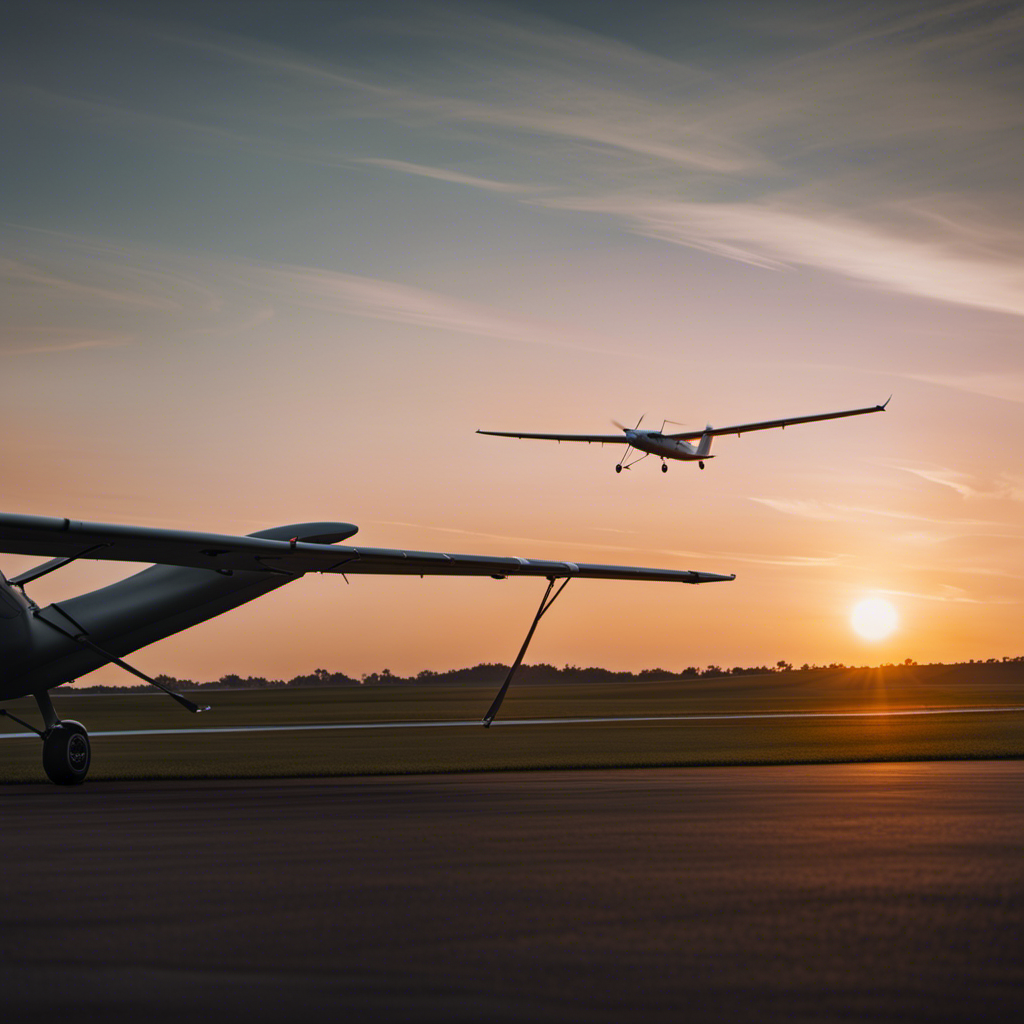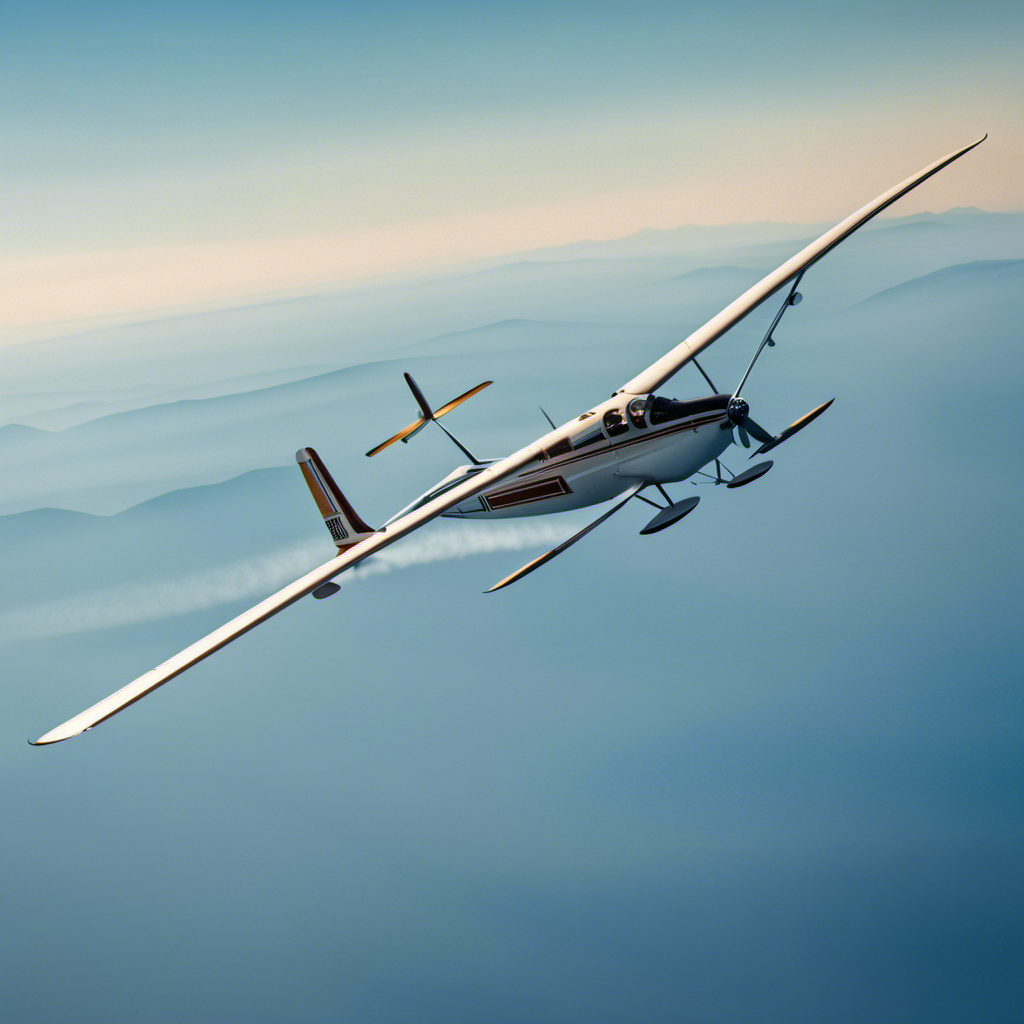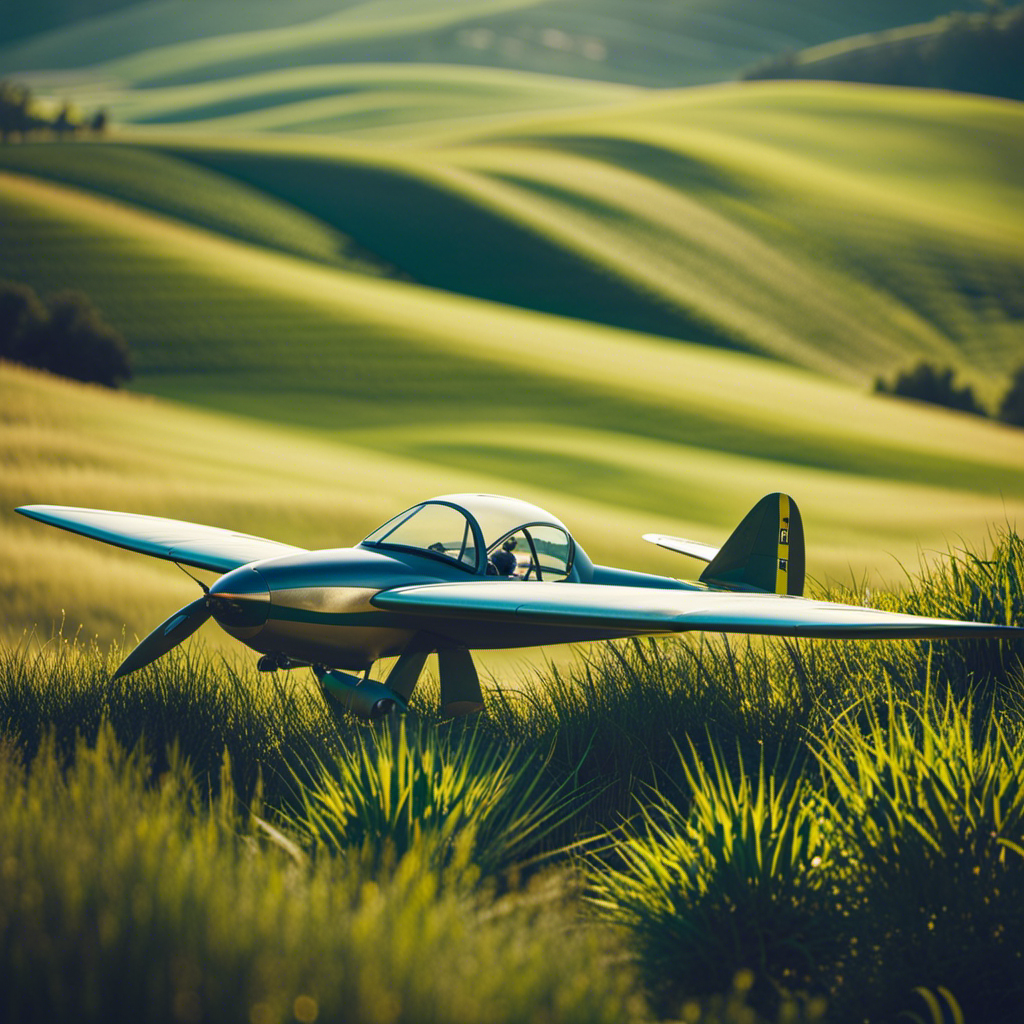Imagine yourself soaring through the air, feeling the wind brush against you as you navigate through the clouds. If you’ve ever dreamed of becoming a glider pilot, you’re in the right place.
In this article, I’ll guide you through the process of obtaining your glider pilot license, from understanding the requirements to passing the exams. With a reputable flight school and dedication to training, you’ll soon be enjoying the freedom and exhilaration of glider flying.
Let’s get started on your journey to the skies!
Key Takeaways
- Minimum age requirement is usually 16 years old.
- Completion of specific flight hours and passing a flight test are necessary.
- Ground school, theory lessons, and practical flight lessons are part of the training program.
- Necessary paperwork, documentation, and medical examination are required for the application process.
Understand the Requirements and Eligibility Criteria
To get a glider pilot license, you’ll need to understand the requirements and eligibility criteria. The first requirement is age. In most countries, you must be at least 16 years old to obtain a glider pilot license.
Another requirement is physical fitness. You must undergo a medical examination to ensure that you are fit to fly.
Additionally, you need to have a good understanding of aviation theory and pass a written exam. This includes knowledge of aerodynamics, weather, navigation, and emergency procedures.
Furthermore, you must complete a specific number of flight hours, which varies depending on the country’s regulations.
Finally, you’ll need to demonstrate your practical skills by passing a flight test.
Understanding these requirements and eligibility criteria is crucial before embarking on your journey to become a glider pilot.
In order to pursue a glider pilot license, it is important to find a reputable glider flight school.
Find a Reputable Glider Flight School
When looking for a reputable glider flight school, you should start by researching different options in your area.
It’s crucial to find a school that not only provides comprehensive training but also has experienced instructors who can guide you through the process.
Look for schools that offer a variety of glider flight school options, such as introductory flights, private pilot programs, and advanced training courses.
Consider the qualifications and experience of the instructors, as they play a vital role in your learning journey.
A reputable glider flight school will have knowledgeable instructors who can teach you the necessary skills and ensure your safety throughout the training.
Once you have found the right school, you can confidently enroll in a glider pilot training program, taking the first step towards obtaining your glider pilot license.
Enroll in a Glider Pilot Training Program
When it comes to enrolling in a glider pilot training program, there are three key components to consider: ground school and theory lessons, practical flight lessons, and simulator training.
Ground school and theory lessons are essential for building a strong foundation of knowledge and understanding of the principles of flight, weather patterns, and navigation techniques.
Practical flight lessons allow students to apply the knowledge gained from ground school in real-life flying scenarios, honing their skills and building confidence.
Additionally, simulator training provides a valuable opportunity for pilots to practice and refine their flying techniques in a controlled and safe environment before taking to the skies.
Ground School and Theory Lessons
You’ll need to attend ground school and theory lessons to obtain your glider pilot license. Ground school is an essential part of the training program, where you will learn the fundamental knowledge required to become a skilled glider pilot.
The ground school curriculum covers a wide range of topics, including aerodynamics, meteorology, navigation, regulations, and safety procedures. These theory lessons provide a solid foundation and understanding of the principles that govern glider flight. By learning the theory behind flying, you’ll be better equipped to make informed decisions and handle various situations in the air. Understanding aerodynamics, for example, can help you optimize your glider’s performance and efficiency.
These theory lessons also ensure that you have a comprehensive understanding of the rules and regulations that govern glider operations. Now that you have a solid theoretical foundation, it’s time to move on to the next phase of your training: practical flight lessons and simulator training.
Practical Flight Lessons and Simulator Training
During practical flight lessons and simulator training, you’ll have the opportunity to apply the knowledge gained from ground school and theory lessons in a real-world setting. These hands-on experiences are crucial for developing your practical flight techniques and honing your skills as a glider pilot.
Simulator training, in particular, offers a multitude of benefits. It allows you to practice various flight scenarios, including emergency situations, without the risks associated with actual flight. Simulators provide a safe and controlled environment to learn and improve your decision-making skills, as well as your ability to handle different weather conditions.
Complete the Required Flight Hours and Training
In order to get a glider pilot license, you must complete the required flight hours and training.
The first step towards becoming a licensed glider pilot is to accumulate the necessary flight hours. This involves spending a significant amount of time in the cockpit, gaining practical experience and mastering the art of flying a glider. During this period, you will be taught various techniques and maneuvers, including takeoffs, landings, and emergency procedures.
Additionally, you will undergo extensive training to ensure you are well-versed in glider operations, safety protocols, and navigation procedures. The training will cover topics such as aerodynamics, meteorology, and airspace regulations.
Once you have completed the required flight hours and training, you can then move on to the next phase of the licensing process, which is to pass the written and practical exams.
Pass the Written and Practical Exams
Once you’ve completed the required flight hours and training, the next step is to pass the written and practical exams. These exams are designed to test your knowledge and skills in various areas of glider flying.
To pass the written exam, you will need to study diligently and familiarize yourself with the study materials provided by your flight school or instructor. These materials will cover topics such as aerodynamics, meteorology, regulations, and navigation. It is important to thoroughly understand these concepts and be able to apply them in practical scenarios. The passing score for the written exam may vary depending on your location, so it is essential to check the specific requirements for your country or region.
Once you have successfully passed the written exam, you can move on to the practical exam, where you will demonstrate your flying skills under the supervision of a designated examiner. This exam will assess your ability to safely operate a glider and make informed decisions in different flight situations. It is crucial to practice and refine your flying skills before taking the practical exam to ensure you meet the required standards.
After passing both exams, you will be one step closer to obtaining a student pilot certificate.
Obtain a Student Pilot Certificate
When it comes to obtaining a Student Pilot Certificate, there are a few key points to keep in mind.
First, the application process and documentation can be quite detailed, so it’s important to gather all the necessary paperwork and fill out the forms accurately.
Additionally, there are specific medical certificate requirements that must be met, including obtaining a physical examination from an FAA-approved medical examiner.
Application Process and Documentation
To begin the application process for your glider pilot license, you’ll need to gather all the necessary documentation. The application process may vary slightly depending on your location, but generally, you will need to submit an application form, proof of age and identity, and proof of completion of the required training.
The application form will ask for your personal information, flight experience, and medical history. You will also need to provide copies of your logbook, training records, and any relevant certificates or endorsements. It is essential to ensure that all the required documents are complete and accurate before submitting your application.
Once you have gathered all the necessary documentation, you can move on to the next step, which involves obtaining a medical certificate that meets the specific requirements for glider pilots.
Medical Certificate Requirements
After submitting the necessary documents and completing the application process, the next crucial step in obtaining a glider pilot license is to meet the medical certificate requirements.
As a future glider pilot, it is essential to undergo a medical examination process to ensure that you are physically fit to fly. This examination will assess your overall health and evaluate any conditions that may hinder your ability to operate a glider safely.
The medical certificate, once obtained, demonstrates your fitness to fly and is valid for a specific period. It is important to note that this validity period varies depending on the country and the type of license you are pursuing.
Now that you have met the medical certificate requirements, it is time to build experience and flight time, which will be crucial in the journey towards becoming a skilled glider pilot.
Build Experience and Flight Time
Building experience and flight time is crucial for obtaining a glider pilot license. To become a skilled glider pilot, it is important to spend ample time in the cockpit, honing your skills and gaining practical knowledge.
This involves logging your flight hours in a logbook, recording details such as takeoffs, landings, and different maneuvers performed. By consistently building your skills through flight time, you will become more proficient in handling the glider and navigating through various flight conditions.
Additionally, logging your flight hours accurately is essential for meeting the requirements set by aviation authorities when applying for a glider pilot license. With a solid foundation of experience and flight time, you will be well-prepared to move forward and apply for your glider pilot license, taking your passion for flying to new heights.
Apply for a Glider Pilot License
When you’re ready, you can submit your application for a glider pilot license. Here is the step-by-step process to apply for a glider pilot license:
-
Complete the necessary training: Before applying, you must have completed the required training hours and have obtained the necessary flight experience.
-
Gather the necessary documents: Prepare the following documents to include in your application:
- Proof of age and identity: Provide a valid government-issued identification document.
- Medical certificate: Obtain a medical certificate from an aviation medical examiner.
- Logbook: Submit your flight logbook, which should include your flight hours and experience.
-
Submit your application: Once you have all the necessary documents, submit your application to the relevant aviation authority or governing body. Pay any required fees and ensure that your application is complete and accurate.
By following this process and submitting all the necessary documents, you can be on your way to obtaining your glider pilot license.
Now, let’s explore how you can maintain your glider pilot license without interruption.
Maintain Your Glider Pilot License
To maintain my glider pilot license, it is important for me to stay current with medical examinations and fulfill continuing education requirements. This ensures that I am in good health and capable of safely operating a glider.
Regular medical examinations help identify any potential health issues that could affect my ability to fly. By undergoing these exams, I can address any concerns and take necessary steps to maintain my physical well-being.
In addition to medical examinations, I must also fulfill continuing education requirements. These requirements keep me up-to-date on the latest regulations, techniques, and safety practices in the gliding industry. By staying informed, I can adapt to changes and ensure that I am operating my glider in the safest and most efficient manner possible.
Stay Current with Medical Examinations
Make sure you’re always keeping up with your medical examinations to stay current while pursuing your glider pilot license. Maintaining a valid medical certificate is crucial for ensuring your safety and the safety of others while operating a glider. Here are three important things to consider regarding your medical examinations:
-
Medical certificate renewal: Your medical certificate needs to be renewed periodically, depending on the class of certificate you hold. It is essential to stay aware of the expiration date and initiate the renewal process in a timely manner.
-
Medical conditions to be aware of: Certain medical conditions can affect your eligibility to hold a glider pilot license. It is important to be aware of any medical conditions that may require special attention or clearance from an aviation medical examiner.
-
Regular check-ups: Even if you don’t have any known medical conditions, it is still important to schedule regular check-ups with your healthcare provider. Regular check-ups can help detect any underlying health issues that could potentially affect your ability to fly.
By staying current with your medical examinations, you can ensure that you meet the necessary medical requirements to hold a glider pilot license and continue pursuing your passion for flying.
Next, let’s discuss how to fulfill the continuing education requirements to maintain your license.
Fulfill Continuing Education Requirements
After ensuring that I am in good health by staying current with my medical examinations, it is important for me to fulfill the continuing education requirements necessary to maintain my glider pilot license.
These requirements are put in place to ensure that pilots like myself are up-to-date with the latest safety regulations and best practices in glider flying. Ongoing learning is crucial in a dynamic field like aviation, where new technology and techniques are constantly emerging.
By engaging in continuing education, I can expand my knowledge and skills, making me a safer and more competent pilot. Whether it’s attending seminars, workshops, or online courses, I am committed to staying informed and continuously improving my abilities as a glider pilot.
Enjoy the Freedom of Glider Flying!
Experience the thrill and exhilaration of glider flying! As a glider pilot, I have had the privilege of soaring through the sky and embarking on countless adventures. Gliding offers a unique sense of freedom, where you are not bound by an engine but instead rely on the forces of nature to stay aloft. The feeling of being suspended in the air, with only the sound of the wind rushing past, is truly unparalleled. Glider flying allows you to explore the world from a different perspective, witnessing breathtaking views and discovering hidden landscapes. Whether it’s a peaceful afternoon flight or an adrenaline-pumping aerobatic maneuver, every moment in the glider is filled with excitement and the joy of being one with the sky.
| Advantages of Glider Flying | Soaring Adventures |
|---|---|
| Sense of freedom | Scenic flights |
| Quiet and peaceful | Cross-country trips |
| Eco-friendly | Aerobatic maneuvers |
| Cost-effective | Ridge soaring |
| Skill development | Wave soaring |
Frequently Asked Questions
Are there any age restrictions to obtain a glider pilot license?
Yes, there are age restrictions for obtaining a glider pilot license. The minimum age varies by country, but typically ranges from 14 to 16 years old. The training duration can vary from a few weeks to several months.
How long does it typically take to complete a glider pilot training program?
On average, it takes about 30-50 flight hours to complete a glider pilot training program. Obtaining a glider pilot license offers numerous benefits, including the freedom to soar through the skies and the ability to experience the thrill of flying without an engine.
Can I use my glider pilot license to fly in other countries?
Yes, your glider pilot license can soar across borders! Glider pilot license reciprocity allows you to fly in other countries, but be sure to familiarize yourself with international gliding regulations beforehand.
Are there any medical requirements to become a glider pilot?
To become a glider pilot, you must meet certain medical requirements and physical qualifications. These ensure that you are fit to fly and can handle the demands of piloting a glider safely.
Is it possible to obtain a glider pilot license if I have a criminal record?
Having a criminal record can potentially impact your eligibility for a glider pilot license. It’s crucial to thoroughly review the criminal record implications and eligibility requirements set by the aviation authorities before pursuing your dream of becoming a glider pilot.
Conclusion
Getting a glider pilot license is an exciting journey that requires dedication and effort. By understanding the requirements and finding a reputable flight school, you can enroll in a training program and complete the necessary flight hours and exams.
One interesting statistic is that on average, it takes about 30-40 flight hours to obtain a glider pilot license. Imagine soaring through the clouds, feeling the wind on your face, and experiencing the freedom that glider flying brings.
So why wait? Start your adventure today and embrace the world of glider flying!
With a heart that soars as high as the skies, Aria, affectionately known as “Skylark,” is the driving force behind Soaring Skyways. Her journey into the gliding world began as a young dreamer gazing up at the soaring birds, yearning to experience the weightlessness and freedom they embodied. With years of experience both in the cockpit and behind the scenes, Aria’s commitment to the gliding community is unwavering.










